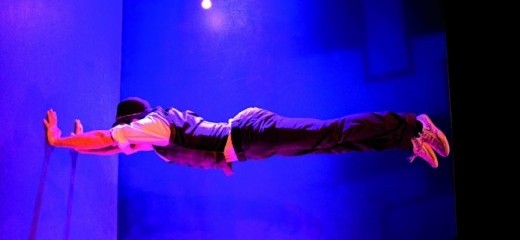
Photo: Heiko Kalmbach
A Box Full of Illusions
by Whitney Weinstein
Audience members looked sideways, upside down, and always, wide-eyed. With a strong influence from circus arts and theatrics, LEO invited viewers to watch performer William Bonnet from multiple perspectives.
Bonnet casually waited in a room of four sides: a floor, two adjacent walls of different blues, and a third, red wall to the audience’s right. A bare bulb hung in the upper left corner, illuminating him with hat and suitcase.
To the left of this room, blocked from Bonnet’s sight by a blue wall, was a projection screen reaching from the stage to the drapes. Here theater-goers could choose to watch a recorded version of LEO, played in sync with the live performance. The head-turning twist: the red wall on the stage was the floor in the video projection.
LEO, a past winner of the Best of Edinburgh Award, was clever and funny. The character developed a playful curiosity with the constraints of gravity. He sat on the floor in the video, but onstage was lying on his back. He crawled up the wall. He did handstands lying on his stomach. His positions grew more complex, and spectators gasped in question: which way is up? The screen featured his perspective of gravity, while the live version offered a different viewpoint.
Bonnet shrieked in amazement as he threw his hat up the wall or suspended his suitcase in what seemed to be mid-air. He told a story while confronting physical boundaries and visual understanding. LEO manipulated props, character execution, and presentation, to create optical illusion and rich entertainment.
Using a piece of chalk from his suitcase, Bonnet illustrated his walls with household items and pets which came to life. A bowl with an animated fish spilled and flooded the scene, forcing Bonnet to swim through a sea of whales and catfish. His perception of reality, what we watched on the screen, contrasted with the reality of what we saw on stage. The show gradually brought us to understand Bonnet's alternate awareness and imagination.
Once the room drained of sea water and creatures, he attached his suitcase to the actual red wall, so it appeared to linger in the air, at last challenging the audience’s sense of realism. Thinking outside of his box, Bonnet opened the suitcase and placed his foot through it, beyond the wall’s perimeters. He lowered himself (or slid parallel to the floor, depending on which way you’re watching) beyond the bottom of the suitcase, past the wall, and out of sight, closing the suitcase behind him.
Credit for this eyeful also goes to Daniel Brière, director, Tobias Wagner, original performer, and Gregg Parks, creative producer.
LEO, Y2D Productions with Chamaleon Productions, Arts Bank at The University of the Arts, Sept. 12-15, 17-22, httl://www.fringearts.com/festival/2013/leo.cfm
By Whitney Weinstein
September 18, 2013

